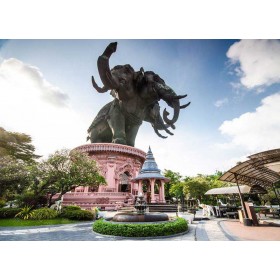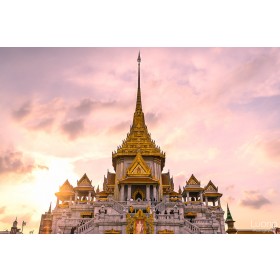×
Login Form
×
Registration
Profile Informations
Login Datas
or login
- Description
Details
The Grand Palace Tour in Bangkok
Royal Grand Palace, the foremost dazzling sight all told of Kingdom of Thailand and one in every of the goodwonders of Asia is Wat Phra Kaew or the Temple of the Golden Buddha,with the adjoining Grand Palace.These area all interesting places that's a requirement to see for travelling to Krung Thep or Bangkok and therefore the temple and palace grounds area unit full of a unclear range ofother buildings and sacred structures that may all be seen with the Royal Grand Palace and Emerald Buddha Tour.Do not miss out on this tour in Krung Thep that's the highlight of any visit to Krung Thep town.These icons give associate field lexicon of the country and therefore the single most comprehensive introduction to the physical and cultural charms of Kingdom of Thailand.
The Grand Palace Bangkok's History
The Kingdom of Thailand has a history stretching back 800 years, and there have been four capital cities, namely, Krung Sukhothai, Krung Sri Ayutthaya, Krung Thonburi and Krung Ratanakosin (Bangkok). King Rama I moved the capital, now Bangkok, to the east bank of the Chao Phraya River and named the new capital "Ratanakosin Indra Ayothaya."
The Construction of the Grand Palace Bangkok, Thailand
When King Rama I decided to create a new capital, he also began construction of new palace on 6th May 1782, which was at first built entirely of wood and surrounded by a log wall. Construction of the capital and the Grand Palace Bangkok, which occupies an area of approximately 132 rai began in earnest in 1783, as did the construction of the fortifications and gates surrounding the palace. In the Second Reign, the Royal Grand Palace was expanded to the south and more forts were added increasing the total area to 152 rai 2 ngan. The lengths of the walls were 410 meters on the northern side, 510 meters on the eastern side, 360 meters on the southern side and 630 meters on the western side, and remain unchanged until the present day.
The Architecture of the Grand Palace Bangkok is exceedingly beautiful, combining religious and royal significance. a tradition inherited from the former capital of Ayutthaya.

The Construction of the Temple of the Emerald Buddha
Construction of Wat Phra Sri Ratanasasadaram (the Temple of the Emerald Buddha or Wat Phra Kaew) as the Royal Chapel within the Grand Palace Bangkok followed an ancient tradition, that of Wat Mahathat which was built inside the grounds of Sukhothai's royal grand palace and Wat Phra Sri Sanphetch the royal temple built inside the grounds of Ayutthaya royal palace. In accordance with this tradition the Wat Phra Sri Ratanasasadaram (Wat Phra Kaew) was built inside the grounds of the Grand Palace Bangkok, Thailand to house the city's Emerald Buddha Image. Construction of the temple began in 1783 and was completed in 1785. In accordance with ancient practice King Rama I then held another coronation in Wat Phra Sri Ratanasasadaram (Wat Phra Kaew) in 1785
The Grand Palace Bangkok was the residence of the kings, queens, princes, princesses, ladies-in-waiting and official from 1783 until 1925. The Temple of the Emerald Buddha (Wat Phra Kaew), is a royal temple situated within the Grand Palace in accordance with ancient tradition.
Itinerary of Grand Palace Bangkok Tour, Thailand
07.30 am: Pick up from the various hotel
08.30 am: Group will be transferred to Wat Phra Keaw, The chapel of The Emerald Buddha, which houses the World's most precious image of the lord Buddha, the 75 cm statue of jade sits atop an 11 m golden pedestal surrounded by Lavish Murala and richy decorated pavilions. Then group will be moved to visit the Grand Palace which encompass several major building. The most prominent building include the Throne hall, the Reception hall and the Coronation hall
12.00 pm: Return to hotelIncluded: Transportation / All admission fee as in the itinerary / English Speaking Guide
Exclude: Personal expenses / Option TourRemark: (Bangkok Grand Palace Dress Code)
• Restriction: Please do not wear shorts, sandals, no-sleeves T-shirts. Camera may not allow to use inside some buildings.
• Duration of Our Tour: Morning 08.00 am - 12.00 pm / Afternoon 12.00 pm - 16.00 pm
• Things to Know: The Emerald Buddha, a dark green statue, is in a standing form, about 66 centimeters (26 in) tall, carved from a single jade stone (Emerald in Thai means deep green color and not the specific stone). It is carved in the meditating posture in the style of the Lanna school of the northern Thailand.
• Transfer Service: Pick up from Bangkok Central area, area outside will subject to an extra charge. Please inform your pick up information while you doing the booking process. We will inform your pick up by email.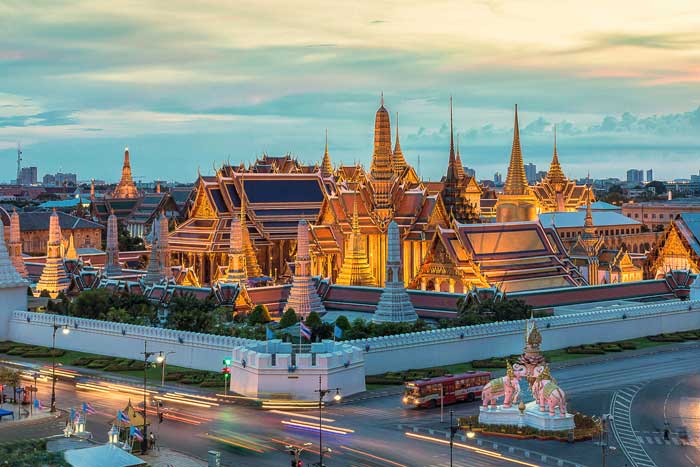
The Grand Palace Bangkok is divided into different areas as followed:
The Outer Zone, situated at the front of the Grand Palace on the northern side, is where various government offices are situated, including those for military officials, civil officials, the harbor department and the royal treasury.
The Middle Zone, situated at the center of the Grand Palace, where the Phra Mahaprasart and Phra Ratchamonthien are located, was until 1925 the residence of the king, the queen, the princes, the princesses, the royal concubines, ladies-in-waiting and female officials.
The Inner Zone, at the rear of the Grand Palace includes the building where members of the royal family and royal attendants, as well as princes under 13 years of age used to reside.
Sanam Chai is as small lawn within the walls of the Grand Palace situated on the eastern side in front of Sala Sahathai Samakhom and near the walls of the Emerald Buddha Temple (Wat Phra Kaew) located to the north.
Wat Phra Kaew “Wat Phra Sri Ratanasasadaram”, familiarly called “The Temple of the Emerald Buddha”, is a royal temple situated within the Grand Palace in accordance with ancient tradition of Thailand. Wat Phra Kaew houses the Emerald Buddha Image and was constructed in 1783.
Sanam Luang (Phra Meru ground), located outside the walls of the Grand Palace and its front, was copied from Ayutthaya and is used for various royal ceremonies.
Visiting the Grand Palace Bangkok, Don’t miss to visit:
- The Emerald Buddha Image, which was carved from a block of jasper, is the most important Buddha image in Thailand. The image itself measure 66 cms. high include the base and 48.3 cms. wide, in the attitude of meditation. Judging from the image’s style, the Emerald Buddha in Wat Phra Kaew is of northern Thai workmanship and was probably made in 15th century There are three different costumes of the Emerald Buddha, one of season, they are summer, rainy season and winter. The first two seasons costumes were made in the reign of King Rama I and the last one for winter was made in the reign King Rama III, all made of gold and jewelry. The ceremony of changing the costume of the Emerald Buddha takes place three times a year, at the beginning of new season by the King.
- Mural Paintings on the Gallery Walls: Phra Rabiang is the wall that surrounds the entire temple of the Emerald Buddha. The mural on the walls of this gallery depict the story of Ramakian in its entirety with short captions beneath the pictures. The gallery is divided into 178 chambers. The story of Ramakian begins in the first chamber at Gate No. 7 on the right, opposite the Viharn Yod, while on the left is the final segment of the Ramakian, in chamber No. 178. In addition, the murals on the columns and the walls leading from the gates relate 80 episodes of Phra Narai’s story before his avatarn (reincarnation) as Phra Ram.
- Photo with 12 giants. All giants are created to protect the Emerald Buddha according to Thai legend. According to the story of Ramakian Mural Paintings on the Gallery Walls, Thosakan Giant is the main character who have the duty to be the royal guard and protector of the Emerald Buddha. There are 2 big giants in each 6 gates around Wat Phra Kaew Bangkok and they all have their name and story as followed:
- At Gate No.1 Koeysadet (Front) Gate, they are Suriyaphob, on the left and Indrachit, on the right.
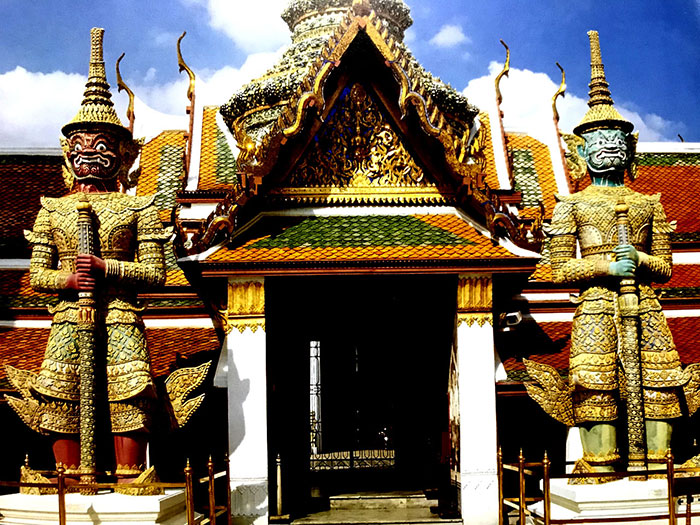
- Suriyaphob, a giant with a bright red body, was the son of Thao Chakrawad, ruler of Krung Maliwan and friend of Thosakan. He Holds the Mekhaphat spear had magical power. After a thousand incantations, not even the angels could withstand it. According to legend the spear was thrown at Phra Satarut and made him faint. Sariyaphob, the giant was slain by Phra Phrot using his Phrommat arrow.
- Indrachit, a giant with a green body, was the beloved son of Thosakan and Naang Montho. His name was originally “Ronaphak Kumarn” because of his potent powers. Because he defeated Phra Indra, his name was changed to Indrachit. He was given sacred weapons by Phra Isuan, Brahma, and Phra Narai including the Phrommat, Nagabat and Vishnupanam arrows. Finally Indrachit, like Mangkornkan before him, was killed by Phra Ram’s Phrommat arrow.
- At Gate No.1 Koeysadet (Front) Gate, they are Suriyaphob, on the left and Indrachit, on the right.
- Gate No. 2, Na Wua Gate is on the eastern side of the temple, directly opposite the Phra Ubosot, or chapel. In front of the gate, inside the temple, two 6-meter tall plaster giants beautifully decorated with glazed colored tiles, stand guard. They are Mangkornkan, on the left, and Virulhok, on the right.
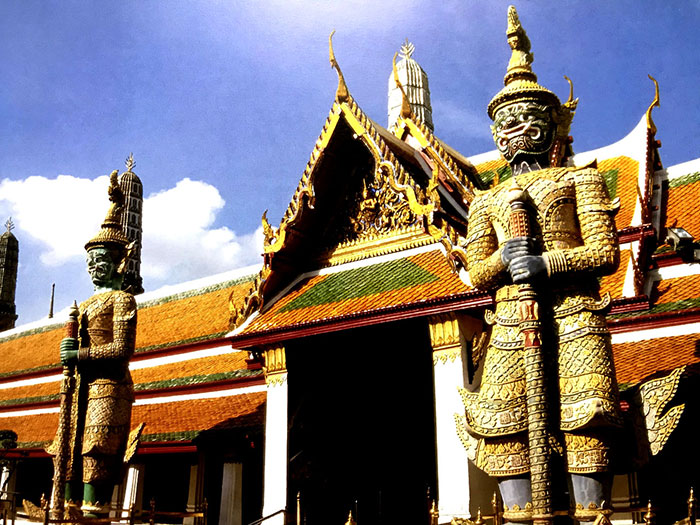
- Mangkornkarn, a giant with a green body, was the son of Phya Khon, ruler of Romkhal City and friend of Thosakan. He was Thorphee, an ungrateful buffalo, that had been reincarnated as a giant and who was cursed by Phra Isuan to die by Phra Ram’s arrow. Finally, Mangkornkan was indeed killed by Phra Ram’s Phrommat arrow.
- Virulhok, a giant with a dark blue body, was the ruler of Maha Anthakarn, the subterranean world. He once caused Mount Krailart, the abode of Phra Isuan, to subside. This happened when he went for an audience with Phra Isuan and was affronted by gecho which cried out at his every step as he bowed to Phra Isuan. In anger, he threw a sash at the gecko, which caused such a tremor that the Krailart mountain subsided.
- Gate No. 3, Phra Sri Ratanasasada Gate, on the northern side of the Wat Phra Kaew, connects to the middle zone of the Grand Palace Bangkok. At the front of the gate, they are Thosagirithorn on the left and Thosagirivan, on the Right.

- Thosagirithorn was the son of Thosakan and an Elephant. His body was light brown in color and the tip of his nose was an elephant’s trunk. Thao Asakanmara, the ruler of Duram City and a friend of Thosakan, asked Tosakan for Thosagirithorn so that he could raise him as an adopted son. Thosagirithorn was armed with a magical bow and arrows which, when shot, sepearated into nine different types of weapons but he was none the less killed by an arrow shot by Phra Lak.
- Thosagirivan was the twin giant of Thosagirithorn. His body was light green and the tip of his nose was an elephant’s trunk. Thao Asakan-mara also adopted him as a son. He, like Thosagirithorn, was also armed with a magical bow and arrows which, when shot, separated into nine different types of weapons. Finally, like his twin brother, he was also killed by an arrow shot by Phra Lak.
- Gate No. 4 Hermit Gate is located at the back of the Sahathia Samakhom Building. At present the gate is used by tourists as an entrance to the temple. Inside, there is a statue of the hermit Cheewaka Komarapach which has healing powers. At the front of the gate, they are Chakrawad, on the left and Asakan-mara, on the right.
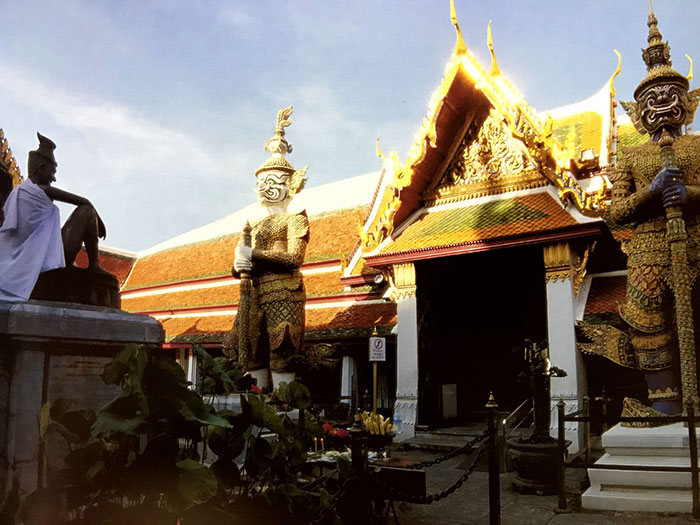
- Chakrawad, a chief of giants possessed a white body, as a friend of Thosakan and the ruler of Maliwan City. He had strong magical powers. His city was protected by a ring of fire and had an acid frontier. He assumed an important role in the story of Ramakian after the death of Thosakan as leader of an army to retake Lanka City from Thao Thosagiriwong (Phiphek) and to return it to Phaina Suriyawong, a son of Thosakan and Naang Motho. Chakrawad changed Phaina Suriyawong’s name to Thao Thosaphin who then ruled Lanka city.
- Asakan-mara, also a chief of giants, possessed a purple body and was the ruler of Duram City and a friend of Thosakan. He was also known as Asakan-marasoon. Asakan-mara was given a special blessing by Phra Isuan whereby any part of his body that was severed would become another body. The more body parts severed, the more new bodies would be formed. Finally, Asakan-mara was stuck by a Phrommat arrow from Phra Ram’s bow and the power of the arrow was such that it blew all his body parts into a river thus preventing them from forming new bodies and he was killed.
- Gate No. 5, Koeysadet (Rear) Gate, is the middle gate on the western side. The road passing in front of Sala Sahathai Samakhom passes by this gate. In front of the gate, there is a ramp for mounting elephants and an undressing pavilion. The gate is kept permanently shut. At the front of the gate, they are Thosakan, on the left and Sahasadecha, on the right.
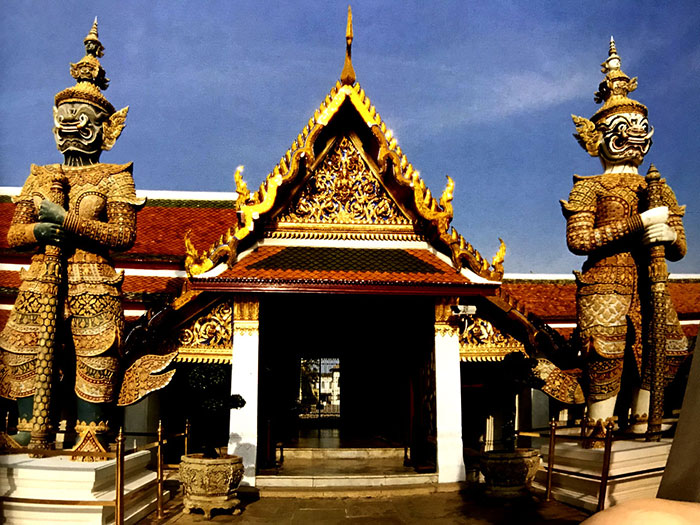
- Thosakan or Ravana, a giant with a green body, was the ruler of Lanka City. He had 10 faces and 20 hands and each hand was armed with a weapon. His chief consort was Naang Montho while the next in rank was Naang Kal-akee. Thosakan was the reincarnation of Nonthok (the giant who washed the feet of angels on Mount Krailat.) He was the father of Naang Sida, whose mother was Naang Montho, but because he was unaware of this fact he went to war with Phra Ram to win Naang Sida in the story of Ramakian.
- Sahasadecha, a chief of giants with a white body, was the ruler of Pangtan City. His younger brother, Phya Moonphlam, was a viceroy and friend of Thosakan. Sahasadecha was a giant with 1000 faces and 2000 hands. His most important weapon was a Tan club. He was killed by Hanuman.
- Gate No. 6, Sanam Chai Gate is the third gate on the western side facing Sanam Chai, a small area of lawn, in front of Sala Sahathai Samakhom. At the front of the gate, they are Maiyarab, on the left and Virulchambang, on the right.
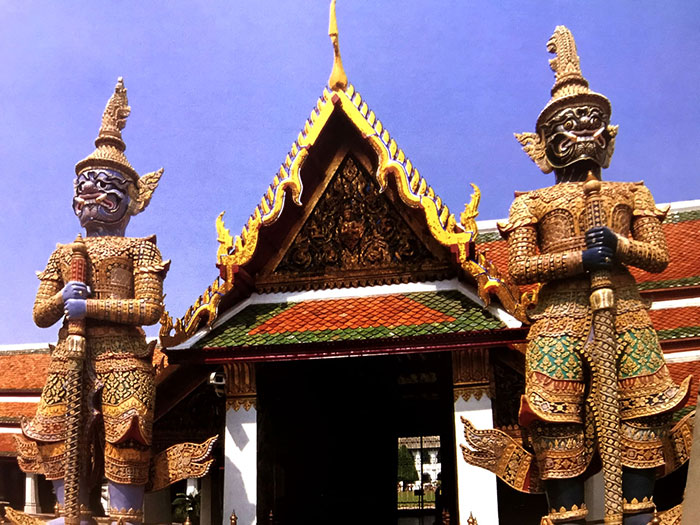
- Maiyarab, a chief of giants with a light purple body, was the ruler of the subterranean world and a friend of Thosakan. He was the stepfather of Machanu, a son of Hanuman and Suphanmacha. It was he who cast a spell on Phra Ram’s army and then kidnapped and held him in an iron cage in the subterranean world. Hanuman succeeded in rescuing Phra Ram and killed Maiyarab.
- Virulchambang, a giant with a blackish-white body, was the son of Phya Toos, the ruler of Charuek City and a nephew of Thosakan. He disguised himself as a very tiny water insect and hid in an air bubble but was discovered and killed by Hanuman.

The Grand Palace Bangkok Opening hours: 8:30AM–3:30PM
The Grand Palace Map in Bangkok, Thailand
ThaiTourismGuide can offer travel services such as Bangkok sightseeing, van rental with driver, tour guides for tourists in Thailand. We can arrange your trip for The Grand Palace Bangkok for both join tour and private tour.
Please feel free to contact us to help you plan your trip by informing your e-mail address to get the best deal:
• Your other destination in Thailand (Bangkok, Chiang Mai, Phuket, Pattaya)
• Budget of this trip
• Number of people in your group
• How many day in Thailand (Arrival date, Departure date)
• Your hotel (If you want to reserve hotel with us, please inform your budget or specific the hotel)
• Is there child/ senior in your group?
• Please inform where to go or what you want to do in this trip.
If you don’t have idea at this time, please check our Bangkok sightseeing or Day Trip in Bangkok with our link as followed: https://www.thaitourismguide.com/day-trips/day-trip-in-bangkok.html. We also have many activities or attractions in Thailand for other destination such as Pattaya, Phuket, Chaing Mai, Kanchanaburi, Krabi or Hua Hin.
If you need any specific information about travelling in Thailand, please feel free to contact us.- Reviews
- Tags
You may also be interested in the following product(s)
-

White Orchid River Cruise
As low as: ฿899.00
-
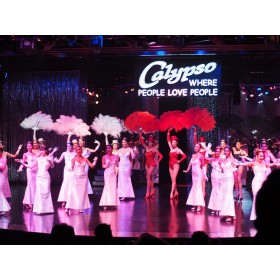
Calypso Cabaret Show
As low as: ฿0.00
-
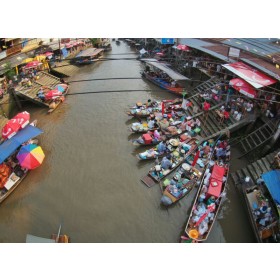
Risky Market and Amphawa Floating Market
As low as: ฿1,000.00



